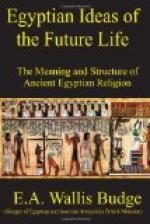The judgment ended, Horus, the son of Isis, who has assumed all the attributes of his father Osiris, takes Ani’s left hand in his right and leads him up to the shrine wherein the god Osiris is seated. The god wears the white crown with feathers, and he holds in his hands a sceptre, a crook, and whip, or flail, which typify sovereignty and dominion. His throne is a tomb, of which the bolted doors and the cornice of uraei may be seen painted on the side. At the back of his neck hangs the menat or symbol of joy and happiness; on his right hand stands Nephthys, and on his left stands Isis. Before him, standing on a lotus flower, are the four children of Horus, Mestha, H[=a]pi, Tuamutef, and Qebhsennuf, who presided over and protected the intestines of the dead; close by hangs the skin of a bull with which magical ideas seem to have been associated. The top of the shrine in which the god sits is surmounted by uraei, wearing disks on their heads, and the cornice also is similarly decorated. In several papyri the god is seen standing up in the shrine, sometimes with and sometimes without the goddesses Isis and Nephthys. In the Papyrus of Hunefer we find a most interesting variant of this [Illustration: Horus, the son of Isis, leading the scribe Ani into the presence of Osiris, the god and judge of the dead; before the shrine of the god Am kneels in adoration and presents offerings.] portion of the scene, for the throne of Osiris rests upon, or in, water. This reminds us of the passage in the one hundred and twenty-sixth chapter of the Book of the Dead in which the god Thoth says to the deceased, “Who is he whose roof is of fire, whose walls are living uraei, and the floor of whose house is a stream of running water? Who is he, I say?” The deceased answers, “It is Osiris,” and the god says, “Come forward, then; for verily thou shalt be mentioned [to him].”
When Horus had led in Ani he addressed Osiris, saying, “I have come unto thee, O Un-nefer, and I have brought the Osiris Ani unto thee. His heart hath been found righteous and it hath come forth from the balance; it hath not sinned against any god or any goddess. Thoth hath weighed it according to the decree uttered unto him by the company of the gods; and it is very true and right. Grant unto him cakes and ale; and let him enter into thy presence; and may he be like unto the followers of Horus for ever!” After this address Ani, kneeling by the side of tables of offerings of fruit, flowers, etc., which he has brought unto Osiris, says, “O Lord of Amentet, I am in thy presence. There is no sin in me, I have not lied wittingly, nor have I done aught with a false heart. Grant that I may be like unto those favoured ones who are round about thee, and that I may be an Osiris greatly favoured of the beautiful god and beloved of the Lord of the world, [I], the royal scribe of Ma[=a]t, who loveth him, Ani, triumphant before Osiris.” [Footnote: Or “true of voice in respect of Osiris;” i.e., Ani makes his petition, and Osiris is to hear and answer because he has uttered the right words in the right manner, and in the right tone of voice.] Thus we come to the end of the scene of the weighing of the heart.




